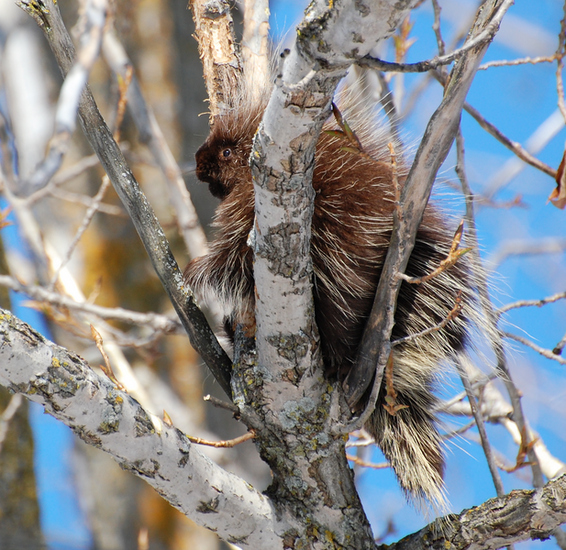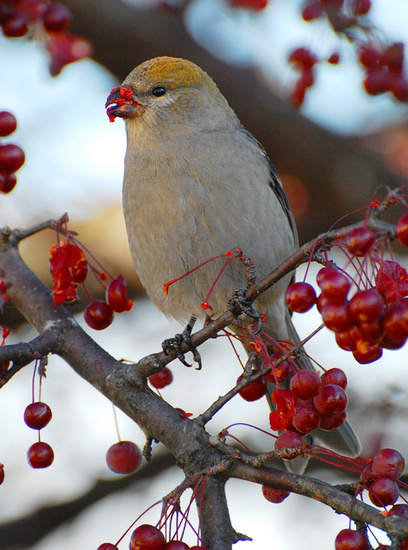
A Feast Of Birch Bark
February 10th, 2013
A little group of porcupines has entertained nature-watchers along Carling Avenue for the last few weeks, eating one of their favorite winter foods, birch bark. The peeling outer layer of birch bark allows them easy access to the inner bark, which is the part they savor. View the first photo at high res to see where patches of bark have been nibbled away.

1680x1050 wallpaper

Life bird #322
February 9th, 2013
Discovering this guy was a treat. At long last, I'm starting to get a respectable amount of owls on my lifelist!

Northern Hawk-Owls are aptly named. They are among the few fully diurnal (active by day, sleeping at night) owls. They tend to perch less upright than other owls, they flick their tails like kestrels, and they're even known to hover over fields to search visually for prey. (Great Grey Owls, by comparison, use their keen hearing to detect the sound of tiny feet scurrying under the snow.) The rusty barring on this bird's breast, combined with his checkered wings, very much reminds me of a Red-Shouldered Hawk. Not to mention this is the first time I've seen an owl on a power line.
Like Great Grey, this is a boreal species that is seldom seen in our area. It was probably driven south by a lack of prey. And it may well be eating birds rather than mice. I noticed the local chickadees were not pleased with its presence.
Preening:

My First Great Grey
January 22nd, 2013
Saw this magnificent fellow in a field along Rockliffe Parkway--a new bird for me.

Great Grey Owls are the tallest owls in North America, and arguably the world. (Some give that title to Eurasian Eagle-Owls instead.) But despite their imposing presence, they're really just big fluffballs. Much of their size comes from the dense plumage that insulates them in the northern climes where they live. And though you'd think that birds that grow up to nearly three feet tall would hunt large prey, their favorite food is tiny voles.
Sightings of this species are normally very rare in Ottawa. But about once every 4-5 years, when the rodent population in the boreal forest crashes, numbers of Great Grey Owls move south in winter in search of food. This is one of those years!


Don't Mind If I Do
January 11th, 2013
A red squirrel helps himself to the birdseed I scattered on a rock. As you may guess from the amount of green and the strength of the sun, I didn't take this photo very recently!

1680x1050 wallpaper
Toughing It Out
January 5th, 2013
A collection of photogenic birds braving the Ottawa winter.

As they did two years ago, Common Redpolls have poured into our area this winter, driven by a low supply of their favorite food (birch seeds) in the far north. I've seen them picking at birch catkins at Stony Swamp, which is neat, but the best way to see them for the purpose of photography is at a feeder, where they can become very tame. This was one of a flock of dozens at the Shirley's Bay feeding station.

Hairy Woodpecker

The tundra-breeding (and inaptly named) American Tree Sparrow is one of the very few sparrows that normally winter in Ottawa. Its warm colors brighten the snowy landscape.

1680x1050 wallpaper
Red-Breasted Nuthatches are spunky little birds, and the ones at Jack Pine Trail are every bit as tame as the chickadees. Sprinkle some seed on a rock or a stump, and you can get some glorious close-ups!

Bohemian Waxwings take a drink from one of the few remaining sources of open water in the city (Rideau River near Hurdman.) When there's no open water to be found, northern birds can get by eating snow.
New Years Hares
January 1st, 2013
I had a wonderful New Year's morning watching a pair of Snowshoe Hares at Hilda Road. Hares are not rare in Ottawa, but they are often hard to see--they camouflage so well, and they're quite shy! This pair were coaxed out of their usual antisocial lifestyle by the prospect of easy food at a platform bird feeder.

Snowshoe Hares are brown for much of the year and easily mistaken for rabbits, but in winter, they morph into pure snowy white to better blend in with the landscape.

Red Squirrel behind. I wish I'd captured the moment when this cheeky squirrel chased the hare, many times his size, away from the feeder.

Rabbits patronize the Hilda Rd. feeders occasionally too. They're easily told apart in winter, since they don't change coats as hares do.
Rough-Legged Hawk
December 9th, 2012
My husband's eagle eyes are to thank for this one. We were driving along Terry Fox on the way to lunch when he spotted a hawk perched atop a streetlight. I thought it likely a Red-Tailed Hawk (the usual common roadside raptor that often perches on manmade things), but what I glimpsed of his underside looked tantalizingly non-red-tailed. After we got home, I grabbed my binos and camera and went back out, managing to find a pull-off area so I could get out and approach him.
He was no Red-Tailed Hawk! He was a Rough-Legged Hawk, a far-northern bird that only visits Ottawa in winter, and a thrilling find for me--I'd never seen and identified one before without the help of more experienced birders. He doubly clinched his identity when he took flight and started hovering over the field edge: first, because of the now-obvious dark "wrist patches", second, because he hovered for at least fifteen seconds straight, something no other buteo in our area would do. It's a unique behavior that they use to search for field mice.

1680x1050 wallpaper

Rough-Legged Hawk legs are feathered to the toes, an adaptation to their cold-weather lifestyle.
Your source for dapper crested frugivores
November 22nd, 2012
You want Bohemians? I got Bohemians. I got 'em noshing, posing, contorting, diving, playing. I even got 'em saying "nyah!" in your general direction.
I spent the morning with a huge, tame flock of Bohemian Waxwings at Herzberg and Legget, watching them feast, immersed in the sound of their gentle trill and the flutter of their wings. I spent about half the time simply blissed out. The rest of the time I took pictures.

1680x1050 wallpaper

1680x1050 wallpaper

1680x1050 wallpaper
( More. Much more. )
The Bandit
November 16th, 2012
Sharing in the feast with the Pine Grosbeaks were Bohemian Waxwings. Large flocks of this boreal species are roving around Ottawa this fall. They had apportioned things neatly with apparently one tree belonging to the waxwings and the other to the grosbeaks. The one the waxwings were in was the one with excellent afternoon lighting. (I kept hoping they would trade places, as my camera struggled with shadows in the grosbeak tree. No such luck.) I even managed to capture their eyes (usually eclipsed by the surrounding black mask), as red as the fruit they were eating.

1680x1050 wallpaper
Unlike grosbeaks, waxwings swallow berries whole. In fact they use fruit in precisely the opposite way, digesting the pulp and juice and excreting the seeds undigested.

1680x1050 wallpaper
Mind you, the swallowing part can be a challenge!

Pine Grosbeaks close to home
November 15th, 2012
It had been almost five years since I last saw Pine Grosbeaks. So I was thrilled to find a flock of them in front of my husband's workplace, pigging out on ornamental fruit trees.
Pine Grosbeaks are large (as big as robins) fruit-loving finches. They're boreal birds who only come south into our area when their native winter food supply (mountain ash berries) is low. Some winters they don't come at all. When they do, they feast on crabapples and ornamental mountain ash berries, making a good living at places like Dominion Arboretum. They are amazingly tame. I photographed from six feet away without causing any of them to bat an eye. (Heck, a raven soared overhead croaking menacingly and they didn't bat an eye. Careful, guys--I've seen ravens take down birds bigger than you.)
All of these photos are of females and juveniles. Unfortunately, no adult males (who are a beautiful shade of dusky rose red) were present.
They also have to be the world's messiest eaters. Unlike waxwings who eat the whole fruit, Pine Grosbeaks crush and discard the pulp to get at the seed within, leaving berry innards all over the ground and all over their faces.

1680x1050 wallpaper



|
